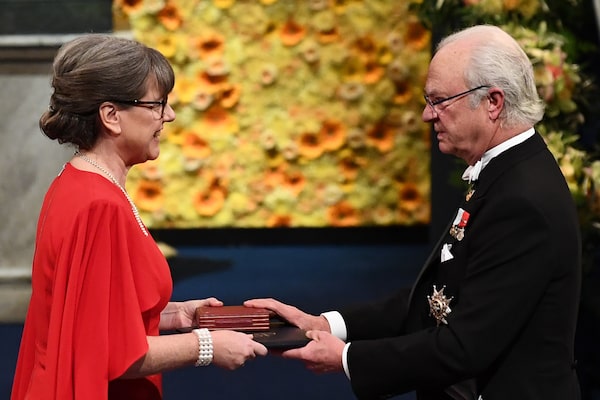
Canadian physicist Donna Strickland receives her Nobel Prize from from King Carl XVI Gustaf of Sweden during the 2018 award ceremony on Dec. 10, 2018 at the Concert Hall in Stockholm, Sweden.JONATHAN NACKSTRAND/AFP/Getty Images
A Canadian scientist who became one of just three women to win the Nobel Prize for Physics received her award at a formal ceremony in Sweden on Monday as supporters at her Ontario university cheered her on from halfway across the world.
Donna Strickland, a professor at the University of Waterloo, was recognized for being half of the team to discover Chirped Pulse Amplification, a technique that underpins today’s short-pulse, high-intensity lasers and became the crucial component to corrective eye surgery.
The 59-year-old from Guelph, Ont., made the discovery in the 1980s, while completing her PhD at the University of Rochester in New York, and shares half of the US$1.01-million prize with her doctoral adviser, French physicist Gerard Mourou. The other half of the prize went to Arthur Ashkin of the United States, who was the third winner of the award.
Related: Canada’s newest Nobel Prize winner, ‘just wanted to do something fun’
Strickland, whose win was announced in early October, received her prize from Sweden’s King Carl XVI Gustaf at a ceremony in Stockholm.
Back in Canada, faculty, staff and students gathered at the University of Waterloo to watch a live broadcast of the proceedings, bursting into cheers and applause as a smiling Strickland walked across a stage to pick up her award.
“Universities around the world would dream of receiving a Nobel Prize amongst their professoriate,” said university spokesman Matthew Grant. “This is a huge moment for our Nobel prize winner, our campus and for Canada as a whole.”
The crowd on campus ate Swedish berries, chocolate gold coins and cookies with Strickland’s likeness on them as they took in the ceremony.
Strickland’s win ended a 55-year-long drought for female physicists at the Nobels. She joins the ranks of Marie Curie, the first woman to claim the honour in 1903, and 1963 winner Maria Goeppert-Mayer.
It also marked the first time a Canadian female physicist has won the award.
Meghan Koo, a medical physics student at the University of Waterloo, said watching Strickland receive her Nobel prize made her proud to be a female physics student.
“Witnessing one of our professors receive her NobelPrize as the first Canadian woman in physics to do so is incredibly inspiring at the just the beginning of my career in physics,” Koo wrote on Twitter.
Maryam Nasirpour, who identified herself as a graduate of the University of Waterloo, said Strickland was a motivating figure.
“I couldn’t be more proud to be a #Canadian and #UWaterloo alumni. Thank you for inspiring girls like me,” she tweeted.
Strickland has said her personal win marks a sign of progress for her male-dominated industry.
“It’s true that a woman hasn’t been given the Nobel Prize since then, but I think things are better for women than they have been,” Strickland told The Canadian Press shortly after her win was announced in October. “We should never lose the fact that we are moving forward. We are always marching forward.”
Kirsty Duncan, the federal minister of science and sport, said Strickland’s win marked “a momentous day” for women in the fields of science, technology, engineering, and mathematics.
The impact of Strickland’s research was highlighted at Monday’s ceremony by a Nobel official who pointed out that study on creating more powerful lasers had stalled by the mid 1980s. The problem, he said, was that the intensity of the lasers destroyed the material that was designed to amplify it.
Strickland and Mourou figured out how to bypass that problem by creating laser pulses and then compressing those pulses.
“This method changed the landscape of research about high intensity lasers from something that had been carried out in a few large laboratories to something that could be done in many cases around the world, leading to a powerful surge in development,” he said.
The University of Waterloo said the Swedish royal family was set to welcome Nobel laureates to a dinner with the king in Stockholm on Tuesday.